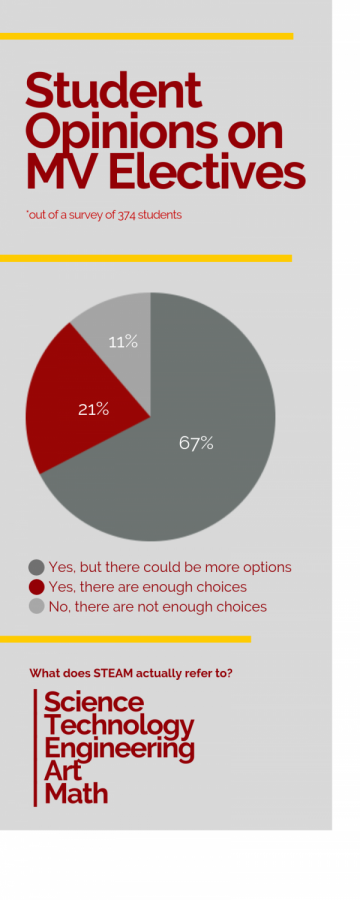Losing the A in STEAM
Decreased demand for arts electives leads to fewer opportunities to pursue the arts in school
September 19, 2018
Sixteen classes from various fields were cut at Monta Vista for the 2018-19 school year because of a decrease in student enrollment. In addition, students self-selecting science, technology, engineering and math (STEM) electives has lowered the demand for arts electives, decreasing the number offered.
AP Computer Science (APCS) teacher David Greenstein mentions that while STEM programs like APCS and Java have not been affected in terms of number of sections, the brunt of the cuts seem to fall on the arts programs. He asserts that in a community that emphasizes STEM, people can often overlook the skills that a nontechnical education can offer.
“Everybody likes the arts, but they always consider it secondary in this community,” Greenstein said. “I think we’re a little bit too much STEM-focused and we need to have more art and music and things like that because it prepares the brain so that they can do math [or] chemistry. A lot of discoveries that were made in the sciences came out of things that are totally unrelated.”
Photography and art teacher Tyler Cripe agrees, adding on that classes on arts and the humanities are necessary for a well-rounded high school schedule because of the basic skills they teach.
“I think that there can be more done outside of the requirement to educate the students about the qualities of those classes and how they would relate to things like the… traditional STEM fields,” Cripe said. “We have lots of art students who go into art school and end up doing something like interface design and they end up being better computer designers than computer programmers who go through all the classes that try to skip over into design. The skills you learn in art are transferable to other things, and I don’t think that’s always recognized.”
 However, offering every student a class in the arts is not always feasible when taking into account all high school requirements. Due to the recent changes in the FUHSD district bell schedule, the school day is now starting and ending later, which can affect students’ availability for specified events.
However, offering every student a class in the arts is not always feasible when taking into account all high school requirements. Due to the recent changes in the FUHSD district bell schedule, the school day is now starting and ending later, which can affect students’ availability for specified events.
According to Cripe, trying to add an extra seventh period class can become harder when the school day ends later and students are trying to fit in other extracurriculars like a sport. Because the school district has committed to starting the day after eight o’clock and must comply with the law, there are a lot of different factors that contribute to the scheduling struggle, he said.
From a different perspective, junior Alicia John, who took both APCS Principles and Art 1 last year, mentions that she feels like the school already offers a solid variety of elective courses. She reasons that the popular demand for STEM-focused classes justifies the elective courses available, considering it would be difficult to implement classes for just a few students.
“I actually think it’s really nice,” John said. “I feel like there is a good range [of elective choices]. Theoretically it would be nice to have [classes for] anyone interested in them, however I know that realistically that’s hard to do.”
To address the lack of demand, one solution Cripe proposed was to advertise the advantages experience in the arts can offer by having more art alumni nights. Students of MVHS would then be able to hear from former students and their parents as they speak on their paths to an arts career.
“If you don’t have information and you don’t hear it directly from people’s experiences, then [learning more about a subject] can seem like something that can be hard to do, or useless,” Cripe said. “We are taking steps to do that demonstration again, but there’s only so much time in the day.”
















